Russia’s Seaborne Crude Exports Surge To End 2023 On A High
Four-week average shipments grew to the biggest since early November weekly flows were the most since July.

(Bloomberg) -- Russia’s seaborne crude exports ended the year on a high, as four-week average shipments climbed to the highest since early November and weekly flows jumped to the most since July.
About 3.46 million barrels a day of crude were shipped from Russian ports in the four weeks to Dec. 31, tanker-tracking data monitored by Bloomberg show. That was up by 230,000 barrels a day from the period to Dec. 24. The more volatile weekly average jumped by 560,000 barrels a day to 3.78 million.
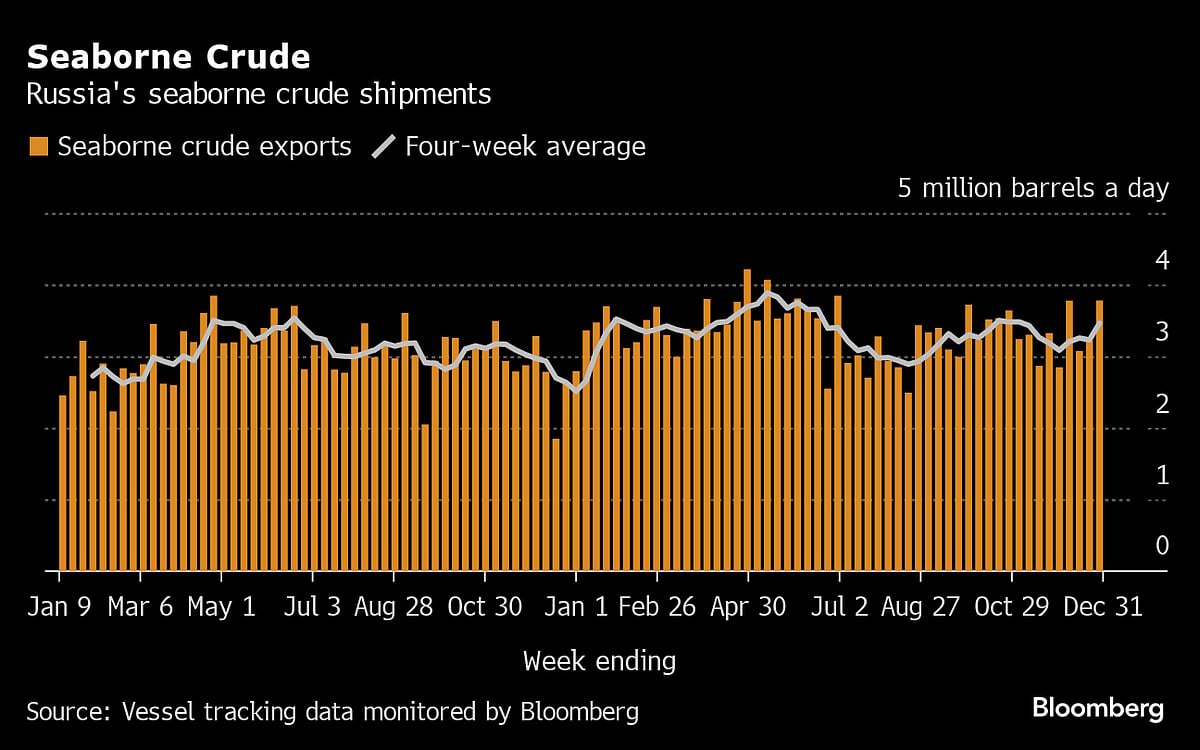
Four-week average crude shipments were about 120,000 barrels a day below their May-June level — the baseline used by Moscow for the reduction in combined crude and product exports it has pledged to its partners in the OPEC+ group.
Russia has said it will deepen its oil export cuts to 500,000 barrels a day below the May-June average during the first quarter of 2024, after Saudi Arabia said it would prolong its unilateral one-million-barrel-a-day supply reduction and several other members of the OPEC+ group agreed to make further output curbs. The Russian cut will be shared between crude shipments, which will be reduced by 300,000 barrels a day, and refined products, according to Deputy Prime Minister Alexander Novak.
For December, the reduction was set at 300,000 barrels a day, spread across both crude and refined products in undefined proportions. That complicates assessments of whether Russia is meeting the commitment to its OPEC+ partners.
About 1.7 million barrels a day of Russia’s crude exports pass through the Red Sea, where merchant vessels are increasingly coming under attack from Houthi rebels in Yemen. Tankers carrying Moscow’s oil are unlikely to be targeted, but that doesn’t rule out the risk of a ship carrying Russian supplies being hit by mistake.
Shipments of Russia’s Sokol crude to India, which takes most of the cargoes of that grade, have faltered. Five out of six ships heading for the ports of Paradip and Vadinar came to a halt in December. Five are now heading back through the Strait of Malacca, though they continue to show their Indian destinations. The sixth remains idle off Sri Lanka.
Four more cargoes of Sokol crude have been loaded onto ships that are also showing destinations in India. Of those, one is anchored east of Singapore, one is idling west of the Philippines and the other two were last seen close to the South Korean port of Yeosu, where they loaded the cargoes via ship-to-ship transfer.
Russia’s oil processing slipped again in late December. More storm warnings for the Black Sea curtailed operations at the Tuapse plant, which ships the bulk of the fuel it produces abroad via the Black Sea.
The Kremlin’s four-week revenues from oil export duties rose to their highest level for the year. Russia has scrapped oil export duties with effect from the start of 2024, with oil producers set to pay higher output taxes.
Flows by Destination
Russia’s seaborne crude flows in the four weeks to Dec. 31 rose to 3.46 million barrels a day. That was up from 3.23 million barrels a day in the period to Dec. 24. Shipments were about 120,000 barrels a day below the average seen in May and June.
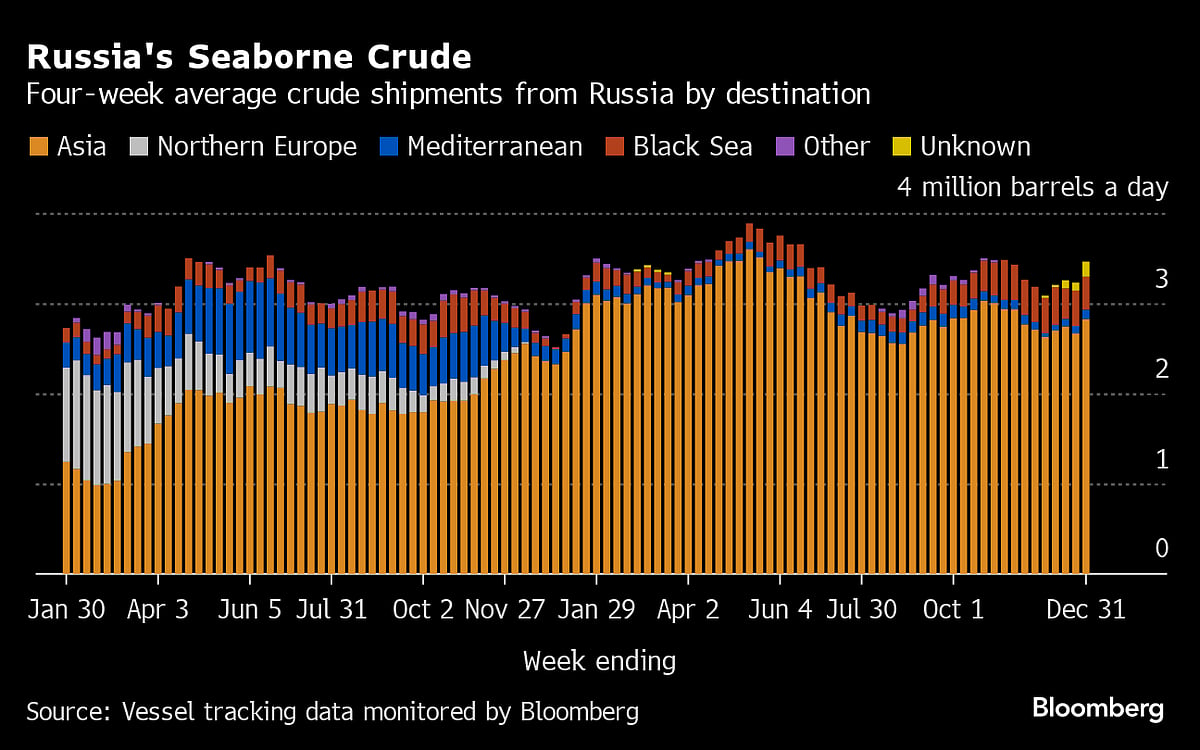
All figures exclude cargoes identified as Kazakhstan’s KEBCO grade. Those are shipments made by KazTransoil JSC that transit Russia for export through Novorossiysk and the Baltic port of Ust-Luga and are not subject to European Union sanctions or a price cap.
The Kazakh barrels are blended with crude of Russian origin to create a uniform export grade. Since Russia’s invasion of Ukraine, Kazakhstan has rebranded its cargoes to distinguish them from those shipped by Russian companies.
-
Asia
Observed shipments to Russia’s Asian customers, including those showing no final destination, rose to 2.99 million barrels a day in the four weeks to Dec. 31, up from 2.75 million barrels a day in the period to Dec. 24. They were the highest since October.
About 1.08 million barrels a day of crude was loaded onto tankers heading to China in the four weeks to Dec. 31. China’s seaborne imports are supplemented by about 800,000 barrels a day of crude delivered directly from Russia by pipeline, either directly, or via Kazakhstan.
Flows on ships signaling destinations in India averaged about 1.03 million barrels a day in the four weeks to Dec. 31.
Both the Chinese and Indian figures will rise as the discharge ports become clear for vessels that are not currently showing final destinations.
The equivalent of about 680,000 barrels a day was on vessels signaling Port Said or Suez in Egypt, or are expected to be transferred from one ship to another off the South Korean port of Yeosu. Those voyages typically end at ports in India or China and show up in the chart below as “Unknown Asia” until a final destination becomes apparent.
The “Other Unknown” volumes, running at about 170,000 barrels a day in the four weeks to Dec. 31, are those on tankers showing no clear destination. Most of those cargoes originate from Russia’s western ports and go on to transit the Suez Canal, but some could end up in Turkey. Others could be moved from one vessel to another, with most such transfers now taking place in the Mediterranean, off the coast of Greece.
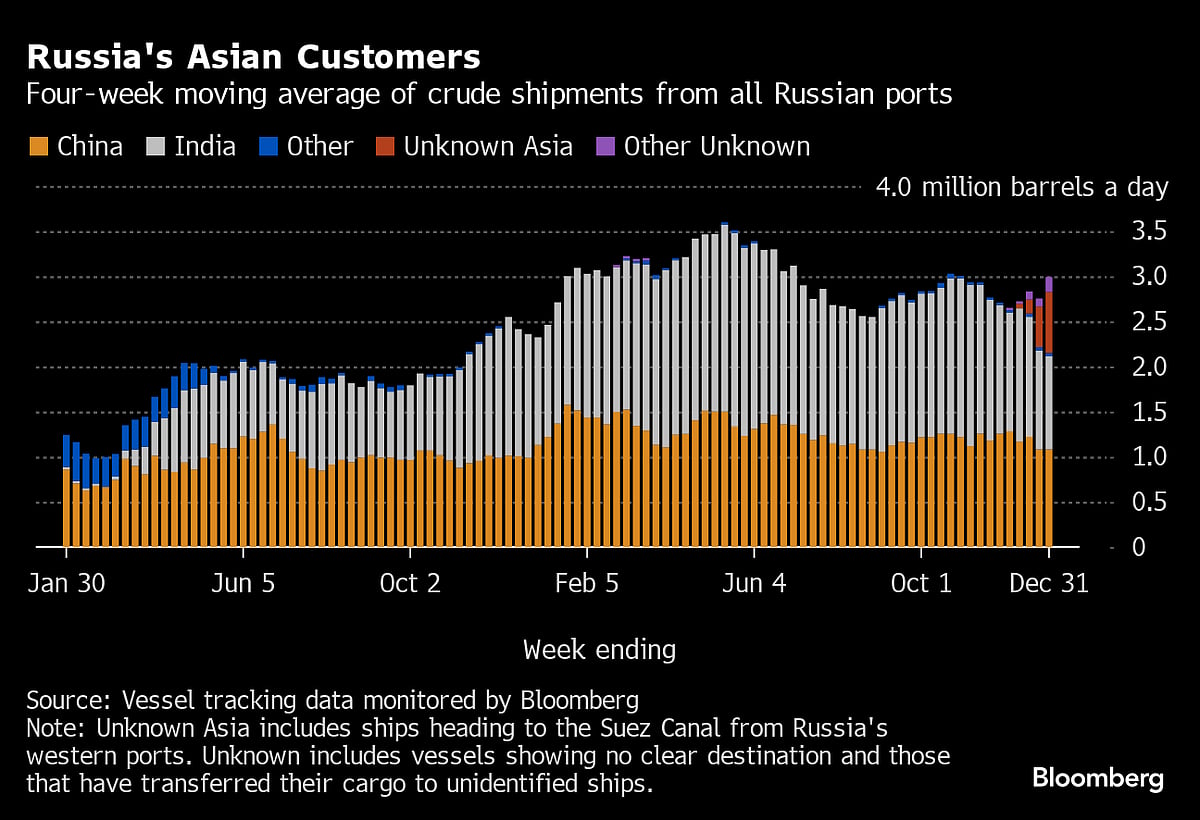
Europe and Turkey
Russia’s seaborne crude exports to European countries have collapsed since Moscow’s troops invaded Ukraine in February 2022. A market that consumed about 1.5 million barrels a day of short-haul seaborne crude, coming from export terminals in the Baltic, Black Sea and Arctic has been lost almost completely, to be replaced by long-haul destinations in Asia that are much more costly and time-consuming to serve.
Combined flows to Turkey and Bulgaria, Russia’s only two remaining buyers close to its western ports, have stabilized between about 450,000 and 500,000 barrels a day, tanker-tracking data show.
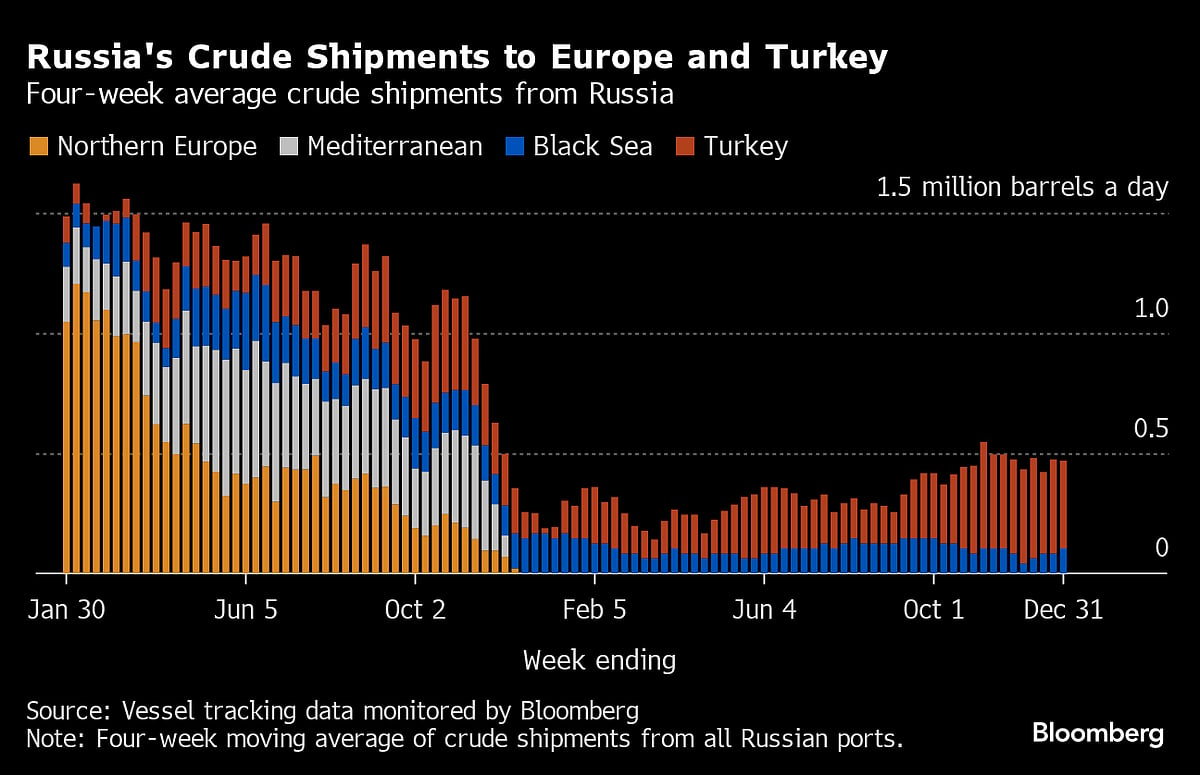
Exports to Turkey edged lower to about 365,000 barrels a day in the four weeks to Dec. 31. They are still close to three times as high as the lows they hit in July and August.
Flows to Bulgaria, now Russia’s only European market for crude, edged up to a six-week high of about 104,000 barrels a day in the most recent four-week period. Flows are recovering from earlier disruption at Novorossiysk, though the halt to shipments from the Black Sea port has affected the average until year-end. Bulgaria’s parliament has approved a measure that will end imports of Russian oil from March, nine months earlier than permitted under an exemption to EU sanctions on purchases of Moscow's oil.
No Russian crude was shipped to northern European countries, or those in the Mediterranean in the four weeks to Dec. 31.
Vessel-tracking data are cross-checked against port agent reports as well as flows and ship movements reported by other information providers including Kpler and Vortexa Ltd.
Export Revenue
Inflows to the Kremlin's war chest from its crude-export duty rose to $89 million in the seven days to Dec. 31. Meanwhile four-week average income also gained, increasing by $5 million to a five-week high of $82 million, its highest in a year.
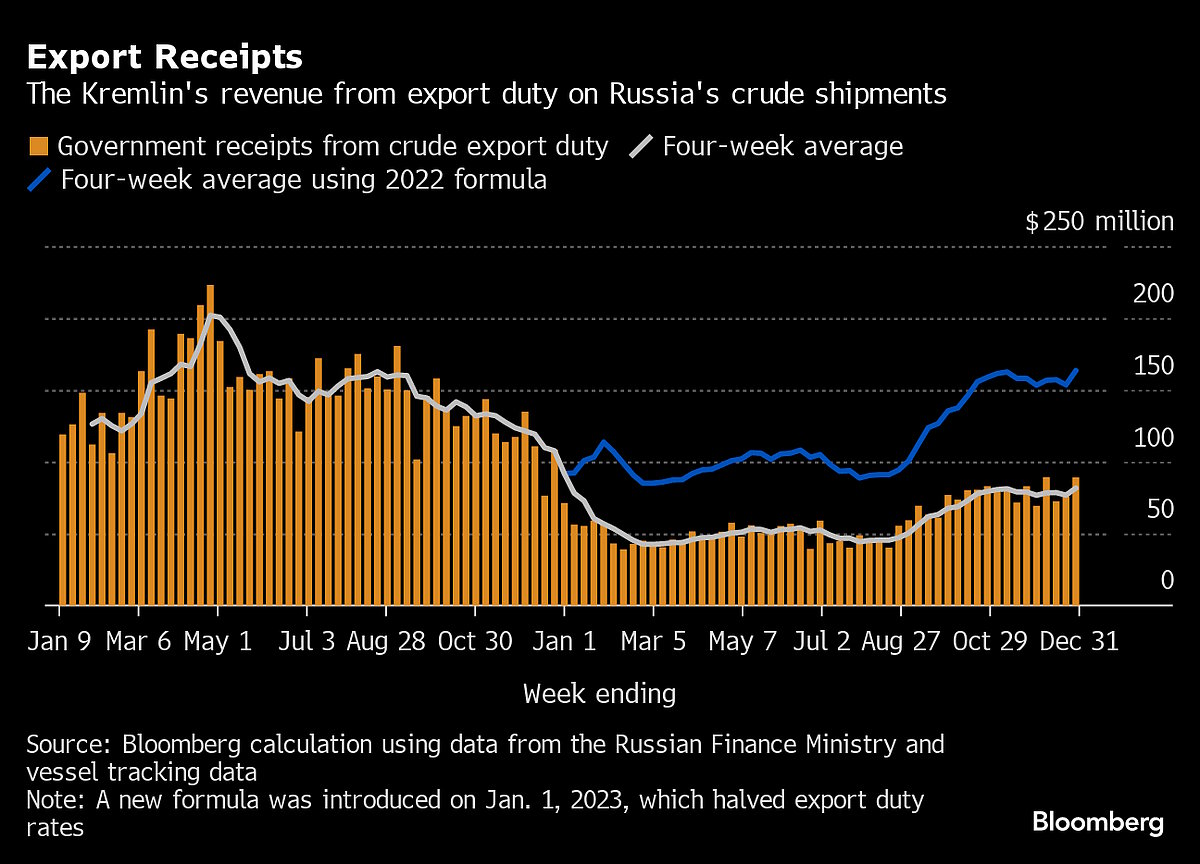
The export duty rate for December was $3.37 a barrel, based on an average Urals price of $79.23 during the calculation period between Oct. 15 and Nov. 14. That was about $9.39 a barrel below Brent over the same period.
Export duty was abolished at the end of 2023 as part of Russia’s long-running tax reform plans.
Origin-to-Location Flows
The following table shows the number of ships leaving each export terminal.
A total of 35 tankers loaded 26.5 million barrels of Russian crude in the week to Dec. 31, vessel-tracking data and port agent reports show. That’s up by about 3.9 million barrels from the figure for the previous week and the highest weekly amount since July.
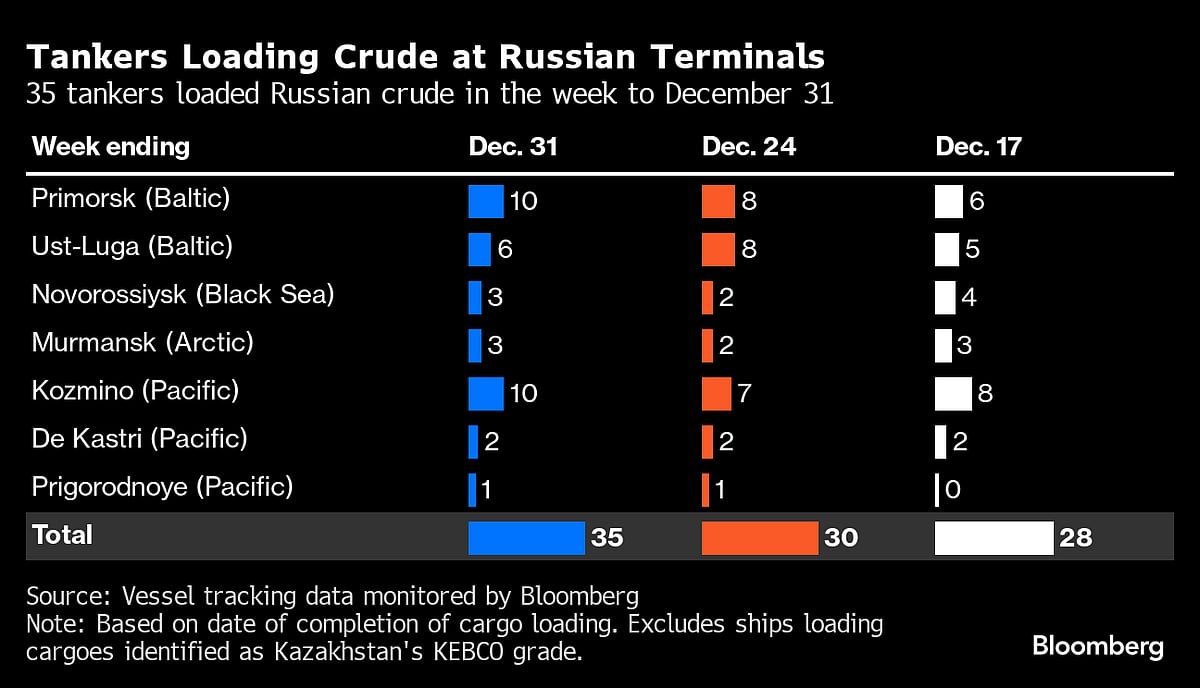
All figures exclude cargoes identified as Kazakhstan’s KEBCO grade. One cargo of KEBCO were loaded at Novorossiysk and one at Ust-Luga during the week.
NOTES
Note: This story forms part of a weekly series tracking shipments of crude from Russian export terminals and the export duty revenues earned from them by the Russian government. Weeks run from Monday to Sunday. The next update will be on Tuesday, Jan. 9.
Note: All figures exclude cargoes owned by Kazakhstan’s KazTransOil JSC, which transit Russia and are shipped from Novorossiysk and Ust-Luga as KEBCO grade crude.
If you are reading this story on the Bloomberg terminal, click here for a link to a PDF file of four-week average flows from Russia to key destinations.
--With assistance from Sherry Su.
More stories like this are available on bloomberg.com
©2024 Bloomberg L.P.